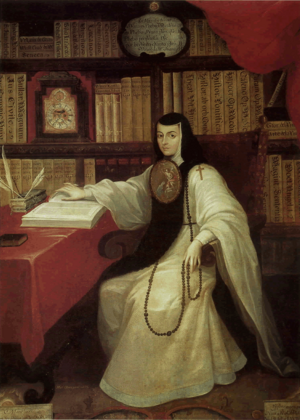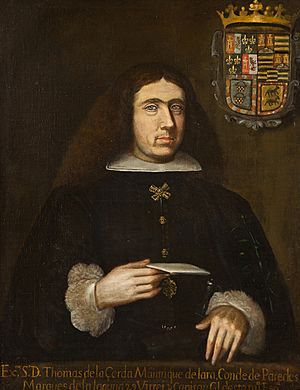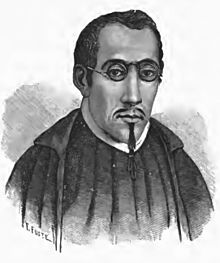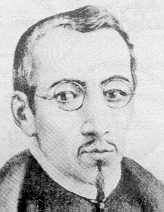Carlos de Sigüenza y Góngora facts for kids
Don Carlos de Sigüenza y Góngora (born August 14, 1645 – died August 22, 1700) was one of the first great thinkers born in the New World. He lived in Mexico City, which was then part of New Spain. He was a criollo patriot, meaning he was proud of New Spain and thought it was special, even more so than Old Spain. Carlos was a polymath, someone who is an expert in many different subjects. He worked in many important government and academic jobs. People often call Sigüenza the da Vinci mexicano, which means the "Mexican da Vinci".
Contents
- Early Life and Studies
- Leaving the Jesuits
- A Career in Science
- Royal Geographer
- Other Work and Writings
- Friendship with Sor Juana Inés de la Cruz
- Collecting Ancient Mexican History
- The Virgin of Guadalupe
- Pride in Mexico: The Triumphal Arch of 1680
- Ideas About Ancient Mexicans
- The 1692 Mexico City Riot
- Later Life and Passing
- Works
- See also
Early Life and Studies
Carlos de Sigüenza y Góngora was born in Mexico City in 1645. His father, Don Carlos de Sigüenza y Benito, came from Madrid, Spain. His mother, Doña Dionisia Suárez de Figueroa y Góngora, was from Seville, Spain. Carlos was the second oldest of nine children and the first boy. He was related to the famous Spanish poet Luis de Góngora through his mother.
Carlos learned mathematics and astronomy from his father. His father had even been a teacher for the royal family in Spain.
Leaving the Jesuits
On August 17, 1660, Sigüenza joined the Society of Jesus (Jesuits) as a new member. He took his first vows on August 15, 1662. However, he was asked to leave the Jesuits in 1668. This happened because he often did not follow their rules and would go out secretly at night.
He was very sorry and asked to be allowed back, but the head of the Jesuits said no. This dismissal was a big disappointment for him. It also meant he would have money problems for the rest of his life. He became a secular priest, which meant he didn't have a regular church job or a steady income. So, he took on many different jobs to support himself and his family. He became a priest in 1673.
A Career in Science
After leaving the Jesuits, Sigüenza studied at the Real y Pontificia Universidad de México (Royal and Pontifical University of Mexico). He was very good at mathematics and became deeply interested in science.
When a teaching job in Mathematics and Astrology became open, Sigüenza wanted to compete for it. Even though he didn't have a special degree in these subjects, he successfully argued that he should be allowed to try. University jobs were given through competitions where candidates had to answer a question within 24 hours. Sigüenza made sure his main rival was watched to prevent cheating. On July 20, 1672, he got the job as a professor of Mathematics and Astrology.
Sigüenza often missed classes because he was busy with his own research or other jobs he took for money. He didn't like astrology, which he thought was "a bad invention" and not real science.
In 1681, Sigüenza wrote a book called Philosophical Manifest Against the Comets Stripped of their Dominion over the Timid. In this book, he tried to calm people's fears about comets. Many people believed comets caused bad events. Sigüenza wanted to show that astrology (superstitious beliefs) and astronomy (scientific study) were different.
He met a Jesuit named Eusebio Kino who had also seen the comet of 1680. At first, they were friendly, but their relationship quickly turned sour. Sigüenza felt that Kino looked down on Mexican-born Spaniards. Kino wrote a strong criticism of Sigüenza's ideas about comets. Sigüenza often mentioned famous scientists like Copernicus, Galileo, Descartes, Kepler, and Tycho Brahe.
In 1690, Sigüenza defended his work by publishing "Libra Astronómica y Filosófica". He directly challenged Kino, saying that no one, "not even Ptolemy himself," could make up rules in science. He believed that only proof and demonstration mattered in science, not authority.
Royal Geographer
In the 1680s, Carlos de Sigüenza y Góngora created the very first map of all of New Spain. This map was highly praised and copied by many. He also drew maps of the water systems in the Valley of Mexico.
In 1692, King Charles II of Spain named him the official geographer for the colony. As the royal geographer, he joined an expedition in 1692 to Pensacola Bay, Florida. The goal was to find good places to defend against the French. He mapped Pensacola Bay and the mouth of the Mississippi River. In 1693, he wrote about the area in Descripción del seno de Santa María de Galve, alias Panzacola, de la Mobila y del Río Misisipi.
Later, in 1698, a Spanish attempt to settle Pensacola Bay failed when a French fleet arrived. Sigüenza was blamed for this by the expedition leader, Andrés de Arriola. However, Sigüenza successfully defended himself against these accusations in 1699.
Other Work and Writings
To earn more money, Sigüenza took on several other jobs. From 1682 until his death, he was the chaplain of the Hospital del Amor de Dios. This job gave him a place to live and a steady income. He also worked for the Archbishop of Mexico, distributing money to poor women.
Sigüenza was not only a scientist but also a poet, writer, historian, philosopher, cartographer, and cosmographer. He was so respected that the French King Louis XIV tried to convince him to move to Paris. He published his first poem in 1662. From 1671 until after his death in 1701, he published a yearly almanac.
In 1690, Sigüenza published a story called Los infortunios de Alonso Ramírez. For a long time, people thought this was Latin America's first novel. However, new discoveries show that this amazing story was actually a true account. It tells the real adventures of a man from Puerto Rico who was captured by English pirates. Sigüenza helped edit Alonso Ramírez's rough story into a better literary piece.
Friendship with Sor Juana Inés de la Cruz

In 17th-century Mexico City, there were two very smart people: Don Carlos de Sigüenza y Góngora and Doña Juana Inés de Asbaje y Ramírez de Santillana, who is known as Sor Juana Inés de la Cruz. We don't know exactly when they met, but they lived close to each other. He lived at the Amor de Dios Hospital, and she lived in a convent.
Even though Sor Juana was a nun and lived in a convent, her order allowed visitors in a special room. She was a brilliant thinker and poet, and Sigüenza encouraged her studies in science. Both were well-known and respected. When a new viceroy arrived in New Spain, both Sigüenza and Sor Juana were asked to design a special arch to welcome him. This was a great honor for them.
Sor Juana's last years were very difficult. When she died in 1695, Sigüenza gave the speech at her funeral. The words of that speech are now lost. But in 1680, he had praised her, saying that her fame "will only end with the world."
Collecting Ancient Mexican History
Sigüenza was very interested in the ancient history of Mexico. After leaving the Jesuits in 1668, he started learning Nahuatl, the language of the Aztecs. He collected many books and documents about indigenous culture.
At the Hospital de Amor de Dios, Sigüenza became good friends with Don Juan, the son of an indigenous nobleman named Don Fernando de Alva Ixtlilxochitl. Sigüenza helped Don Juan with a legal case against Spaniards who were trying to take his land near the great pyramids at San Juan Teotihuacan. In thanks, Don Juan gave Sigüenza his father's collection of manuscripts and codices. This was a very valuable collection of documents about his royal ancestors and the kings of Texcoco.
In 1668, Sigüenza began studying Aztec history and Toltec writing. After Don Juan's father died, Sigüenza inherited the collection. He spent his later years continuously studying Mexican history. Before he died, Sigüenza was very worried about his library. He had spent a lot of effort and money on it. He first wanted his library to go to places in Europe, like the Vatican. But in the end, he left them to the College of San Pedro and San Pablo in Mexico City. He was especially concerned about the native historical documents in his collection.
The Virgin of Guadalupe
Sigüenza wrote a work called Indian Spring (full title: Primavera indiana, poema sacrohistórico, idea de María Santíssima de Guadalupe) in 1662. This writing was part of a wave of works in the mid-17th century about the Virgin of Guadalupe. Sigüenza praised Guadalupe, especially her role in helping to build pride among the criollos (Mexican-born Spaniards).
He believed that the Nican mopohua, the story of the apparition of the Virgin Mary as Our Lady of Guadalupe in the Nahuatl language, was written by Antonio Valeriano. This idea is still believed today. He also said that Fernando Alva de Ixtlilxochitl wrote the Nican motecpana.
Pride in Mexico: The Triumphal Arch of 1680

In 1680, Sigüenza was asked to design a special triumphal arch to welcome the new Viceroy, Cerda y Aragón. Sor Juana Inés de la Cruz was asked to design the other one. These arches were set up in the Plaza de Santo Domingo, near the main square of Mexico City.
No pictures of these arches exist today, but both Sigüenza and Sor Juana wrote descriptions of them. Sigüenza's work was called Theater of Political Virtues That Constitute a Ruler. His title was meant to tell the new viceroy that his time in office was part of a long line of Mexican rulers.
On Sigüenza's arch were images of all twelve Aztec rulers. Each ruler was shown to represent different good qualities for a leader. The god Huitzilopochtli was also shown. Sigüenza said Huitzilopochtli was not a god, but a "chieftain and leader of Mexicans." Sigüenza's huge wooden arch, which was 90 feet high and 50 feet wide, showed the pride of the criollos in the great Aztec past. He hoped that the "Mexican monarchs might be reborn" and be remembered for their "heroic... virtues."
Ideas About Ancient Mexicans
Sigüenza's ideas about the ancient Mexicans came from the valuable manuscripts he inherited from Alva Ixtlilxochitl. He also developed his own theories about where the ancient Mexicans came from. He was one of the first people during Spanish rule to dig around the Pyramid of the Sun at Teotihuacan. He even took an Italian traveler, Giovanni Francesco Gemelli Careri, to that ancient site.
Sigüenza believed that the ancient Mexicans were related to the Egyptians. He thought they were descendants of Naphtuhim, the son of Misraim, who founded Egypt. He even suggested that Naphtuhim was a version of Neptune, the ruler of Atlantis, which he believed was settled by Egyptians. Sigüenza also thought that Saint Thomas the Apostle had visited Mexico and was the same person as Quetzalcoatl, a famous Mesoamerican deity.
The 1692 Mexico City Riot

On June 8, 1692, a huge riot happened in Mexico City. This was a big shock because there had been few challenges to Spanish rule since the early 1500s. A crowd of indigenous people and mixed-race people partly destroyed the viceroy's palace and the city council building. A painting from 1695 by Cristóbal de Villalpando still shows the damage to the viceroy's palace.
Sigüenza wrote a detailed and lively account of the riot. He also shared his own reactions to the dramatic events. His letter is a very important source for understanding the Spanish side of what happened.
In 1692, New Spain faced a severe drought and a disease that attacked wheat. This caused the price of corn to rise a lot, leading to a severe food shortage for the poor. Tensions grew in the capital. The crowd of people asking for help could not meet with the viceroy or the archbishop. After failing to get any official help, the crowd started throwing stones and set fire to major buildings around the main square. Sigüenza bravely saved most of the documents and some paintings from the archives, risking his own life. This act saved many important colonial Mexican documents that would have been lost forever.
Later Life and Passing
In 1693, Sigüenza, along with Admiral Andrés de Pez y Malzarraga, sailed from Veracruz, Mexico. They explored the East Bay River of Florida and the area where the city of Navarre is now located.
In 1694, he retired from the University. His last years were filled with more money and personal problems. He became very ill with what doctors thought were gallstones or kidney stones, causing him great pain. His supporter, Archbishop Aguiar y Seijas, died, and Sigüenza lost his well-paying job as Chief Almoner. He also lost his position as University Accountant. The death of the Archbishop happened around the same time as the deaths of Sigüenza's father and his favorite brother. His dear friend Sor Juana Inés de la Cruz also passed away, and he gave the speech at her funeral. In November 1699, Sigüenza was named a book examiner for the Inquisition. This job paid little and took a lot of time checking books for possible heresy.
As his health worsened, Sigüenza prepared for his death, which came in 1700. Being a scientist until the end, he asked for his body to be autopsied. He wanted doctors to find out what had made him so sick. He said this should be done for the "common good." The autopsy showed a kidney stone the size of a peach.
Sigüenza left his library and scientific tools to the Jesuit Colegio Máximo de San Pedro y San Pablo in Mexico City. He was buried at the chapel of this college. He also left many writings that were not published. Only parts of these survived after the Jesuits were expelled from New Spain in 1767.
Works
- Oriental planeta evangélica, epopeya sacropanegyrica al apostol grande de las Indias S. Francisco Xavier (1662).
- Primavera indiana, poema sacrohistórico, idea de María Santíssima de Guadalupe (1662).
- Glorias de Querétaro (1680) (poem)
- Teatro de virtudes políticas que constituyen a un Príncipe (1680). [Theater of Political Virtues That Constitute a Ruler, Observed in the Ancient Monarchs of the Mexican Empire, Whose Effigies Adorn the Arch Erected by the Very Noble Imperial City of Mexico]
- Glorias de Querétaro en la Nueva Congregación Eclesiástica de María Santíssima de Guadalupe... y el sumptuoso templo (1680).
- Libra Astronomica, y Philosophica en que D. Carlos de Siguenza y Gongora Coʃmographo, y Mathematico Regio en la Academia Mexicana, Examina no ʃolo lo que à ʃu Manifiesto Philosophico contra los Cometas opuʃo el R.P. Eusebio Francisco Kino de la Compañia de Jesus; ʃino lo que el miʃmo R.P. opinò, y pretendio haver demoʃtrado en ʃu Exposicion Astronomica del Cometa del año de 1681 (1690).
- Manifiesto philosophico contra los cometas despojados del imperio que tenían sobre los tímidos (1681).
- Triunfo parthénico que en glorias de María Santíssima... celebró la... Academia Mexicana (1683).
- Parayso Occidental, plantado y cultivado en su magnífico Real Convento de Jesüs María de México (1684).
- Piedad heróica de Don Hernando Cortés, Marqués del Valle (1689).
- Infortunios que Alonso Ramírez natural de la ciudad de S. Juan de Puerto Rico padeció... en poder de ingleses piratas (1690).
- Relación de lo sucedido a la armada de Barlovento en la isla de Santo Domingo con la quelna del Guarico (1691).
- Trofeo de la justicia española en el castigo de la alevosía francesa (1691).
- Letter of Don Carlos de Sigüenza y Góngora to Admiral Pez Recounting the incidents of the Corn Riot in Mexico City, June 8, 1692 (1692)
- Descripción del seno de Santa María de Galve, alias Panzacola, de la Mobila y del Río Mississippi (1693).
- Mercurio volante con la noticia de la recuperacion de las provincias de Nuevo Mexico (1693)
- Elogio fúnebre de Sor Juana Inés de la Cruz (1695).
See also
 In Spanish: Carlos de Sigüenza y Góngora para niños
In Spanish: Carlos de Sigüenza y Góngora para niños
- List of Roman Catholic scientist-clerics




